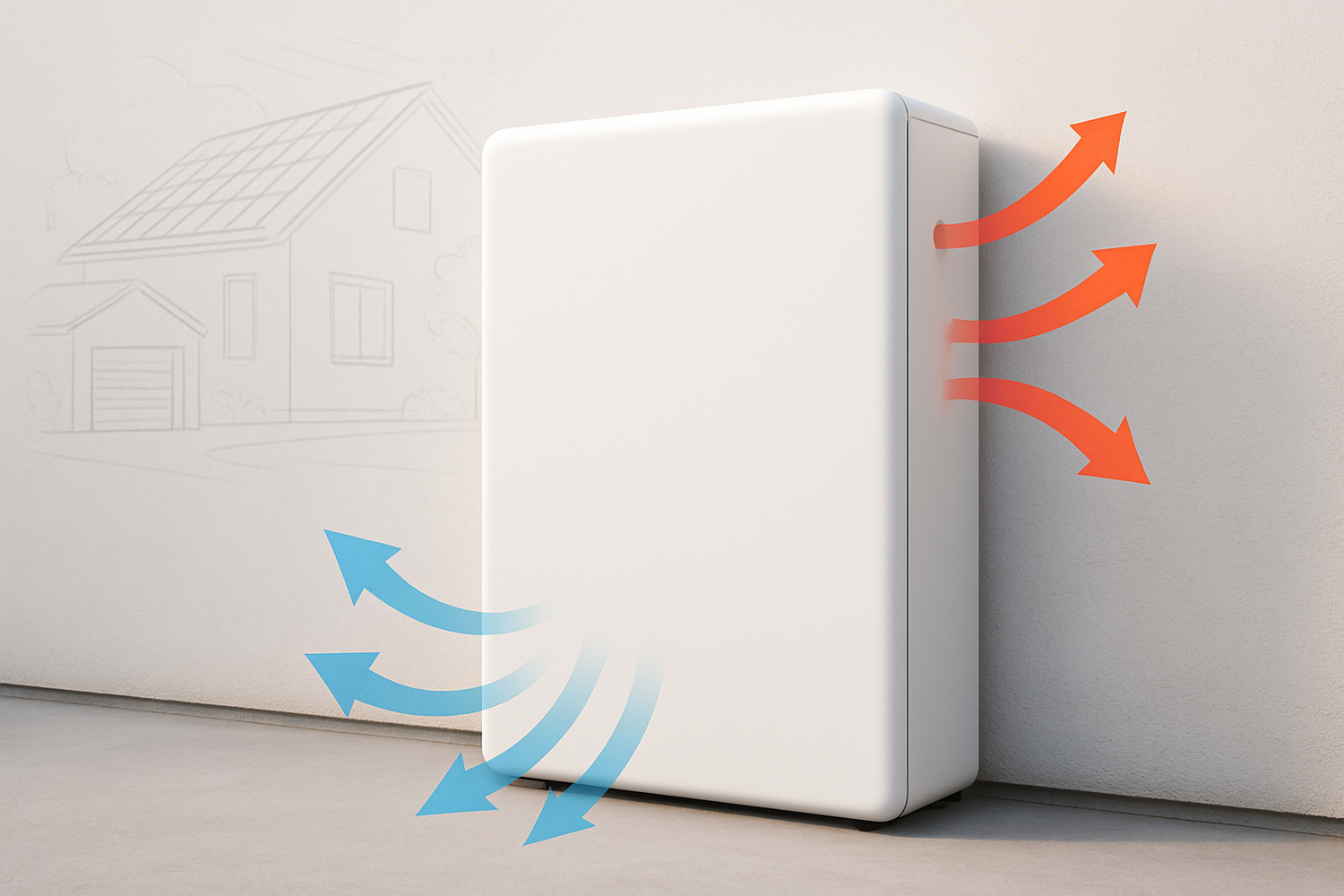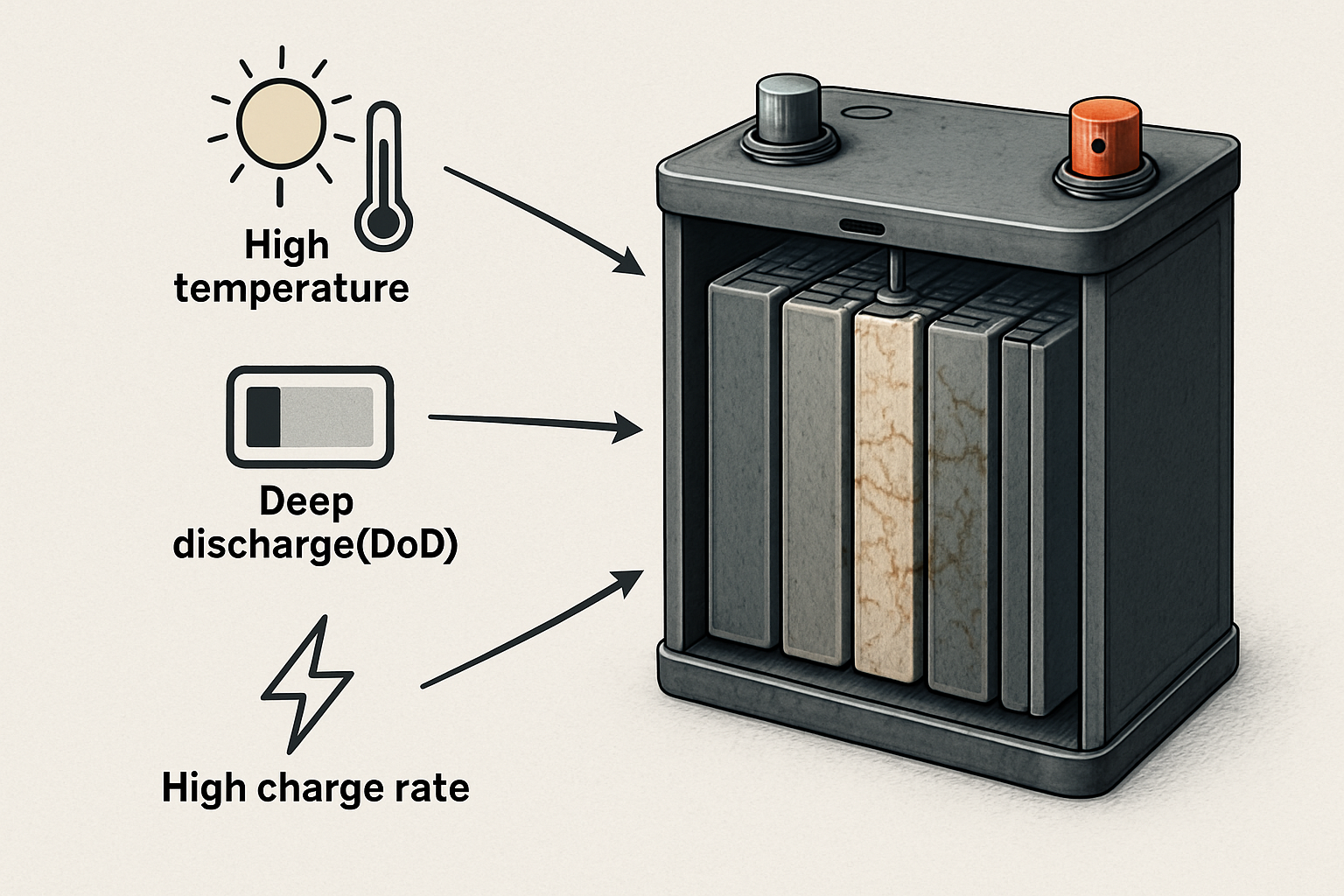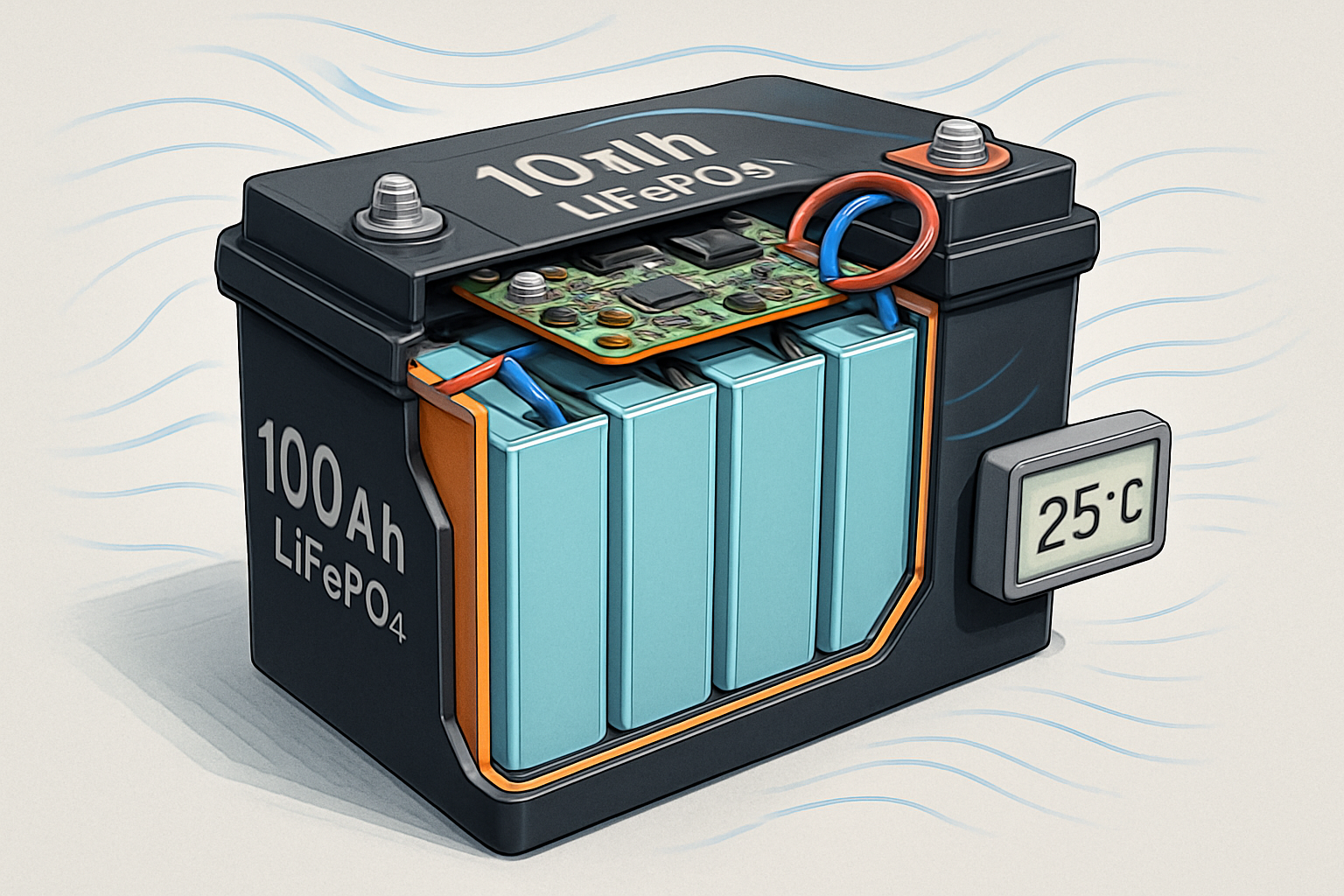Every battery, whether in a smartphone or a home energy storage system, has a finite lifespan. But what truly dictates how long it lasts and how well it performs? The answer lies in a process called battery degradation. This isn't a sudden failure but a gradual loss of capacity and efficiency over time. For anyone invested in solar energy and achieving energy independence, understanding this process is crucial.
This guide explains the science behind why batteries lose their punch and, more importantly, provides practical, actionable strategies to slow this process down. Protecting your energy storage investment starts with knowledge, and here you will find a clear path to optimizing your battery's performance and longevity.
The Science Behind Battery Degradation
To effectively combat battery degradation, we first need to look at what happens inside the battery cell. The processes are complex, but the core concepts are straightforward and essential for anyone managing an energy storage system.
A Look Inside a Lithium-Ion Battery
A lithium-ion battery is a finely tuned electrochemical device. Its main components are the anode (negative electrode), the cathode (positive electrode), a separator, and a liquid electrolyte. During discharging, lithium ions travel from the anode, through the electrolyte, to the cathode, creating an electrical current. During charging, they move back. This constant movement is the basis of the battery's function.
Different materials can be used for the cathode, leading to various lithium-ion chemistries. One of the most stable and safe options for stationary energy storage is Lithium Iron Phosphate (LiFePO4). ANERN focuses on LiFePO4 technology for its solar energy solutions due to its inherent safety, long cycle life, and thermal stability, which are critical for reliable, long-term home power.
Key Mechanisms of Degradation
Degradation isn't a single event but a collection of slow-moving side reactions. The three main physical effects of these mechanisms are a loss of the lithium that can be cycled, a loss of active material on the electrodes, and an increase in internal resistance.
- Solid Electrolyte Interphase (SEI) Growth: During the very first charge, a microscopic layer called the SEI forms on the anode's surface. This layer is actually beneficial, as it controls the reaction between the electrolyte and the anode. However, this layer continues to slowly grow and repair itself over the battery's life, consuming active lithium in the process and increasing internal resistance. High temperatures can accelerate this growth.
- Lithium Plating: Under certain conditions, such as fast charging or very low temperatures, lithium ions don't properly insert themselves into the anode. Instead, they accumulate on the surface as metallic lithium. This process, known as lithium plating, permanently removes lithium from the cycle, reducing capacity.
- Cathode Material Degradation: The physical structure of the cathode material can break down over many charge and discharge cycles. This structural stress can cause tiny cracks, reducing the material's ability to hold lithium ions and contributing to capacity loss.
Understanding these core issues helps separate fact from fiction. For a deeper look into common misunderstandings, consider reading about Lithium Battery Degradation: 5 Myths vs. Proven Facts.
The Primary Causes of Battery Degradation in Real-World Use
While internal chemistry dictates how a battery degrades, external operating conditions determine how fast. Your daily usage habits have a direct and significant impact on your battery's health.
Temperature Extremes: The Silent Killer
Temperature is arguably the most significant factor affecting battery lifespan. Both high and low temperatures accelerate degradation, just in different ways.
- High Temperatures: Heat acts as a catalyst for unwanted chemical reactions. Operating a battery consistently above 35°C (95°F) significantly speeds up SEI layer growth and electrolyte breakdown, leading to faster capacity loss.
- Low Temperatures: Cold weather slows down the electrochemical processes inside the battery. Charging a lithium-ion battery below 0°C (32°F) is particularly dangerous, as it dramatically increases the risk of lithium plating on the anode. At -20°C, a LiFePO4 battery might only deliver about 60% of its rated capacity.
The U.S. Department of Energy's National Renewable Energy Laboratory (NREL) identifies temperature as a key degradation factor that must be considered in battery lifetime prediction models. This is why proper installation and ventilation for your home battery system are not just recommendations—they are requirements for a long service life. You can learn more about the specific factors that impact your system in 5 Hidden Culprits Killing Your Deep Cycle Lithium Battery.
Cycling and Depth of Discharge (DoD)
A "cycle" is one full charge and discharge. The Depth of Discharge (DoD) refers to the percentage of the battery's capacity that is used in a cycle. For instance, using 80Ah from a 100Ah battery is an 80% DoD.
Deeper discharges put more mechanical and chemical stress on the battery's components. While LiFePO4 batteries are robust and can handle deep discharges much better than traditional lead-acid batteries, using shallower cycles can extend their life even further. Consistently discharging to only 50% DoD can result in a much higher total cycle count than consistently discharging to 90% DoD.
| Depth of Discharge (DoD) | Estimated Cycle Life (LiFePO4) |
|---|---|
| 100% | ~2,500 - 3,000 Cycles |
| 80% | ~4,000 - 5,000 Cycles |
| 50% | ~6,000 - 8,000 Cycles |
| ~30% | ~10,000+ Cycles |
Note: These are generalized estimates. Actual cycle life depends on multiple factors.
This is a key differentiator between battery chemistries, as explored in Degradation Showdown: LiFePO4 vs. NMC Solar Batteries.
High Charge and Discharge Rates (C-Rate)
The C-rate measures how quickly a battery is charged or discharged relative to its capacity. A 1C rate on a 100Ah battery means drawing 100 amps. A 2C rate would be 200 amps.
Very high C-rates generate significant internal heat and can strain the battery's internal components, increasing the likelihood of lithium plating. While sometimes necessary, consistently operating at the battery's maximum C-rate will shorten its lifespan. The International Energy Agency (IEA) notes that fast charging remains a challenge that can accelerate battery degradation. Proper system design ensures that your battery operates at a comfortable C-rate for most of its life, a topic covered in Stop Early Wear on Your 100Ah Lithium-Ion Battery.
Proactive Strategies for Battery Performance Optimization
Knowing the causes of degradation is half the battle. The other half is implementing strategies to mitigate them. With the right approach, you can significantly influence your battery’s long-term health.
Smart Charging and Discharging Practices
How you use your battery daily matters. For maximum longevity, it's often recommended to operate within a State of Charge (SoC) window of 20% to 80%. Avoiding keeping the battery at 100% SoC for long periods, especially in high heat, can reduce stress on the cathode. Similarly, avoiding deep discharges below 20% can prevent over-stressing the components. A high-quality Battery Management System (BMS) automates much of this, preventing the battery from operating in dangerous zones. For more tips, see An Expert's Guide to Preventing Battery Degradation.
The Importance of Thermal Management
Given temperature's huge impact, managing it is a top priority. This means ensuring your battery system is installed in a location with adequate ventilation and is shielded from direct sunlight. The optimal operating temperature for most LiFePO4 batteries is between 15°C and 35°C (59°F and 95°F). ANERN's integrated home energy storage systems are designed with this in mind, incorporating passive and active cooling considerations to protect the battery cells and ensure optimal performance.
Choosing the Right Battery Chemistry
The choice of battery chemistry is a foundational decision. For stationary energy storage, where safety and longevity are paramount, LiFePO4 stands out. Its stable chemical structure is less prone to thermal runaway compared to other lithium-ion chemistries like NMC or NCA. The International Energy Agency (IEA) highlights LFP as a suitable chemistry for stationary applications due to its inherent safety, longer lifetime, and non-reliance on cobalt. This aligns with our philosophy of providing reliable, long-lasting energy solutions. Learn How to Maximize Your LiFePO4 Solar Battery's Lifespan?
System-Level Approaches to Mitigating Degradation
Individual practices are important, but a well-designed system provides an essential layer of protection for your battery investment. From electronic safeguards to proper component matching, the entire system works together to promote longevity.
The Role of the Battery Management System (BMS)
The BMS is the brain of your battery pack. It's an electronic circuit board that monitors and manages all critical parameters. A quality BMS is non-negotiable for safety and longevity. Its key functions include:
- Overcharge and Over-discharge Protection: The BMS will cut off the current if the voltage of any cell goes above or below safe limits.
- Cell Balancing: It ensures all cells in the battery pack are at a similar state of charge, preventing individual cells from being overstressed.
- Temperature Monitoring: It constantly checks the battery's temperature and can shut down operations if it gets too hot or too cold.
- Current Limiting: It prevents charge or discharge currents that are too high for the battery to handle safely.
Proper System Sizing and Integration
A properly sized solar energy system is critical. An undersized battery bank will be constantly subjected to deep discharges and high C-rates to meet your energy demands, leading to rapid degradation. Likewise, an inverter that is not correctly matched to the battery's capabilities can cause issues. As a company with deep experience in the solar industry, we focus on providing scalable and fully integrated solutions, like our all-in-one ESS, to ensure every component works in harmony. This holistic approach is key to The Science Behind Solar Energy Storage System Longevity.
Monitoring and Maintenance
Modern energy storage systems offer powerful monitoring tools. Regularly checking your system’s performance data can help you spot potential issues early. Is your system degrading faster than expected? You can find out more in our article: Is Your Home Battery Storage System Degrading Too Fast?. For a deeper dive into evaluating your system's output, our guide on understanding solar storage performance provides detailed metrics and benchmarks.
Building a Long-Lasting Energy Storage System
Battery degradation is an unavoidable physical process, but it is not beyond your control. By understanding the core causes—temperature, deep cycling, and high C-rates—you can actively slow it down. The path to a durable and reliable energy storage system is paved with smart choices.
It begins with selecting the right technology, like robust and safe LiFePO4 batteries. It continues with intelligent system design, where every component is matched and protected by a sophisticated BMS. And it is maintained through mindful usage habits and regular monitoring. By taking these steps, you can ensure your system delivers clean, reliable power for years to come, moving you closer to true energy independence.
Disclaimer: The information provided in this article is for educational purposes only. It is not intended as financial or investment advice. Please consult with a qualified professional before making any decisions related to your energy system.





Leave a comment
All comments are moderated before being published.
This site is protected by hCaptcha and the hCaptcha Privacy Policy and Terms of Service apply.